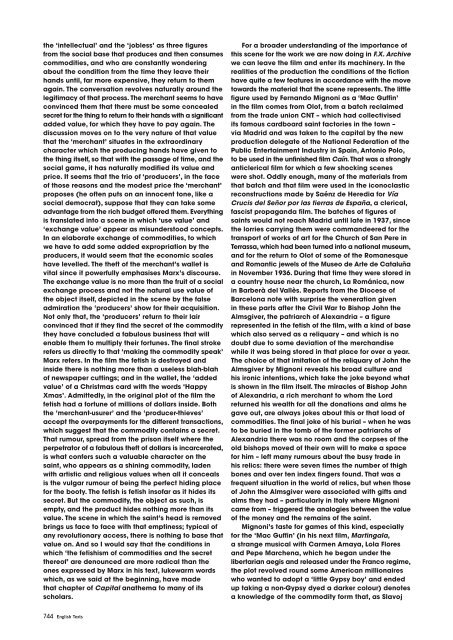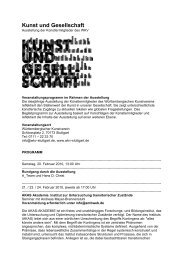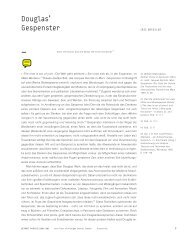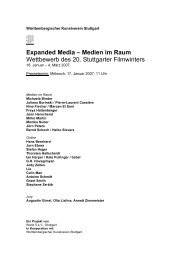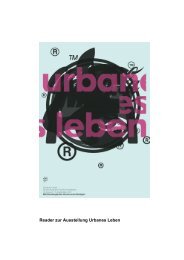English Texts
English Texts
English Texts
Create successful ePaper yourself
Turn your PDF publications into a flip-book with our unique Google optimized e-Paper software.
the ‘intellectual’ and the ‘jobless’ as three figures<br />
from the social base that produces and then consumes<br />
commodities, and who are constantly wondering<br />
about the condition from the time they leave their<br />
hands until, far more expensive, they return to them<br />
again. The conversation revolves naturally around the<br />
legitimacy of that process. The merchant seems to have<br />
convinced them that there must be some concealed<br />
secret for the thing to return to their hands with a significant<br />
added value, for which they have to pay again. The<br />
discussion moves on to the very nature of that value<br />
that the ‘merchant’ situates in the extraordinary<br />
character which the producing hands have given to<br />
the thing itself, so that with the passage of time, and the<br />
social game, it has naturally modified its value and<br />
price. It seems that the trio of ‘producers’, in the face<br />
of those reasons and the modest price the ‘merchant’<br />
proposes (he often puts on an innocent tone, like a<br />
social democrat), suppose that they can take some<br />
advantage from the rich budget offered them. Everything<br />
is translated into a scene in which ‘use value’ and<br />
‘exchange value’ appear as misunderstood concepts.<br />
In an elaborate exchange of commodities, to which<br />
we have to add some added expropriation by the<br />
producers, it would seem that the economic scales<br />
have levelled. The theft of the merchant’s wallet is<br />
vital since it powerfully emphasises Marx’s discourse.<br />
The exchange value is no more than the fruit of a social<br />
exchange process and not the natural use value of<br />
the object itself, depicted in the scene by the false<br />
admiration the ‘producers’ show for their acquisition.<br />
Not only that, the ‘producers’ return to their lair<br />
convinced that if they find the secret of the commodity<br />
they have concluded a fabulous business that will<br />
enable them to multiply their fortunes. The final stroke<br />
refers us directly to that ‘making the commodity speak’<br />
Marx refers. In the film the fetish is destroyed and<br />
inside there is nothing more than a useless blah-blah<br />
of newspaper cuttings; and in the wallet, the ‘added<br />
value’ of a Christmas card with the words ‘Happy<br />
Xmas’. Admittedly, in the original plot of the film the<br />
fetish had a fortune of millions of dollars inside. Both<br />
the ‘merchant-usurer’ and the ‘producer-thieves’<br />
accept the overpayments for the different transactions,<br />
which suggest that the commodity contains a secret.<br />
That rumour, spread from the prison itself where the<br />
perpetrator of a fabulous theft of dollars is incarcerated,<br />
is what confers such a valuable character on the<br />
saint, who appears as a shining commodity, laden<br />
with artistic and religious values when all it conceals<br />
is the vulgar rumour of being the perfect hiding place<br />
for the booty. The fetish is fetish insofar as it hides its<br />
secret. But the commodity, the object as such, is<br />
empty, and the product hides nothing more than its<br />
value. The scene in which the saint’s head is removed<br />
brings us face to face with that emptiness; typical of<br />
any revolutionary access, there is nothing to base that<br />
value on. And so I would say that the conditions in<br />
which ‘the fetishism of commodities and the secret<br />
thereof’ are denounced are more radical than the<br />
ones expressed by Marx in his text, lukewarm words<br />
which, as we said at the beginning, have made<br />
that chapter of Capital anathema to many of its<br />
scholars.<br />
For a broader understanding of the importance of<br />
this scene for the work we are now doing in F.X. Archive<br />
we can leave the film and enter its machinery. In the<br />
realities of the production the conditions of the fiction<br />
have quite a few features in accordance with the move<br />
towards the material that the scene represents. The little<br />
figure used by Fernando Mignoni as a ‘Mac Guffin’<br />
in the film comes from Olot, from a batch reclaimed<br />
from the trade union CNT – which had collectivised<br />
its famous cardboard saint factories in the town –<br />
via Madrid and was taken to the capital by the new<br />
production delegate of the National Federation of the<br />
Public Entertainment Industry in Spain, Antonio Polo,<br />
to be used in the unfinished film Caín. That was a strongly<br />
anticlerical film for which a few shocking scenes<br />
were shot. Oddly enough, many of the materials from<br />
that batch and that film were used in the iconoclastic<br />
reconstructions made by Saénz de Heredia for Vía<br />
Crucis del Señor por las tierras de España, a clerical,<br />
fascist propaganda film. The batches of figures of<br />
saints would not reach Madrid until late in 1937, since<br />
the lorries carrying them were commandeered for the<br />
transport of works of art for the Church of San Pere in<br />
Terrassa, which had been turned into a national museum,<br />
and for the return to Olot of some of the Romanesque<br />
and Romantic jewels of the Museo de Arte de Cataluña<br />
in November 1936. During that time they were stored in<br />
a country house near the church, La Románica, now<br />
in Barberà del Vallès. Reports from the Diocese of<br />
Barcelona note with surprise the veneration given<br />
in these parts after the Civil War to Bishop John the<br />
Almsgiver, the patriarch of Alexandria – a figure<br />
represented in the fetish of the film, with a kind of base<br />
which also served as a reliquary – and which is no<br />
doubt due to some deviation of the merchandise<br />
while it was being stored in that place for over a year.<br />
The choice of that imitation of the reliquary of John the<br />
Almsgiver by Mignoni reveals his broad culture and<br />
his ironic intentions, which take the joke beyond what<br />
is shown in the film itself. The miracles of Bishop John<br />
of Alexandria, a rich merchant to whom the Lord<br />
returned his wealth for all the donations and alms he<br />
gave out, are always jokes about this or that load of<br />
commodities. The final joke of his burial – when he was<br />
to be buried in the tomb of the former patriarchs of<br />
Alexandria there was no room and the corpses of the<br />
old bishops moved of their own will to make a space<br />
for him – left many rumours about the busy trade in<br />
his relics: there were seven times the number of thigh<br />
bones and over ten index fingers found. That was a<br />
frequent situation in the world of relics, but when those<br />
of John the Almsgiver were associated with gifts and<br />
alms they had – particularly in Italy where Mignoni<br />
came from – triggered the analogies between the value<br />
of the money and the remains of the saint.<br />
Mignoni’s taste for games of this kind, especially<br />
for the ‘Mac Guffin’ (in his next film, Martingala,<br />
a strange musical with Carmen Amaya, Lola Flores<br />
and Pepe Marchena, which he began under the<br />
libertarian aegis and released under the Franco regime,<br />
the plot revolved round some American millionaires<br />
who wanted to adopt a ‘little Gypsy boy’ and ended<br />
up taking a non-Gypsy dyed a darker colour) denotes<br />
a knowledge of the commodity form that, as Slavoj<br />
744 <strong>English</strong> <strong>Texts</strong>


